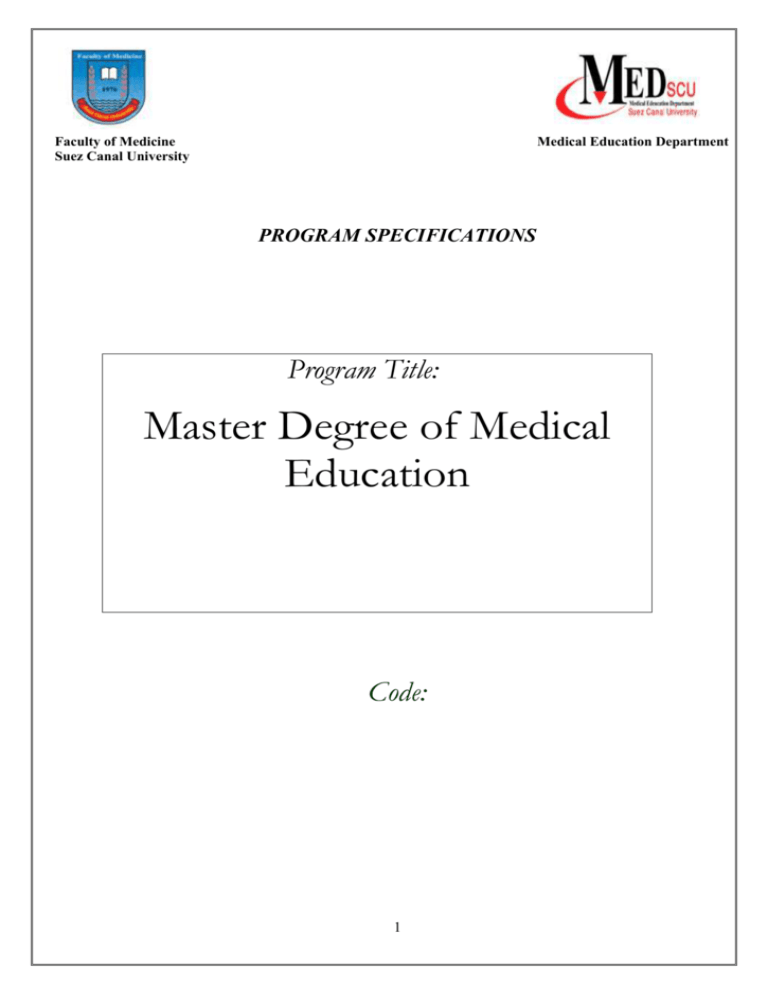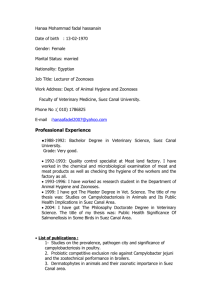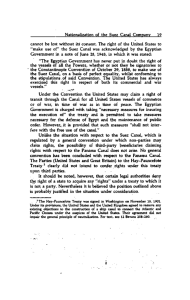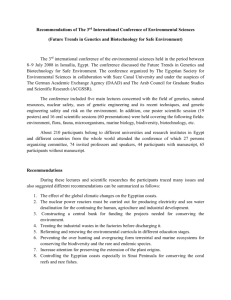Annex E appendix E1
advertisement

Faculty of Medicine Suez Canal University Medical Education Department PROGRAM SPECIFICATIONS Program Title: Master Degree of Medical Education Code: 1 University : Suez Canal University Faculty(s) : Faculty of Medicine Program Specification A- Basic Information 1- Program Title: Master Degree of Medical Education 2- Program Type: Single √ Double Multiple 3- Department (s): Medical Education Department 4- Coordinator: Prof. Wagdy Talaat 5- External Evaluator(s) : Prof. Mostafa Abdel-Nasser 6- Last date of program specifications approval: the bylaws of the Master program in medical education in the Faculty of Medicine, Suez Canal University were approved by the Supreme Council of Universities in 2004. B- Professional Information 1- Program Aim The programs aims at qualifying a cadre of proficient medical educationist to contribute to the advancement of medical education in Egypt and to cope with the era of academic accreditation. The overall aims of the course are that the student: Actively acquires the essential core of up-to-date basic knowledge and skills in Health Professions Education (HPE) equivalent to what is required from a medical educationist. Becomes able to use Health Professions Education knowledge and skills in practice, prevent and solve the relevant institution and workplace problems. Adopts positive attitudes towards humans, the community, and science. Becomes a continuous self-learner. 2 Intended Learning Outcomes (ILOs) of the program a- Knowledge and Understanding: By the end of this program, participants should be able to: a1.Plan for curriculum implementation and analysis a2. Design a curriculum putting into consideration the different learning environments and context as well principles of adult learning. a3.Continuously update their knowledge in the field of innovative strategies in medical education. a4.Apply the principles of Evidence-Based Medicine (EBM) and evidence-based practice. a5.Identify the new and innovative strategies in medical education. a6.Interpret test scores while applying a fair code of assessment practice. a7.Formulate a student assessment plan using appropriate methods of assessment. a8. Plan for conduction of a comprehensive program evaluation while applying ethical considerations of evaluation. a9. Identify the quality management approaches in higher education. a10. Mention the national accreditation process steps and requirements. a11. Identify the main steps and requirements for accreditation of a Health Professions Education Institutions (HPEIs) by a national accrediting body including self-study development. a12. Recognize the role of internal and external audits. a13. Identify the main research methodologies. a14. Define Continuous medical Education (CME). a15. Identify the basic concepts of leadership and management. a16. Use the concepts of leadership and management in improving performance in health organizations and leading reform in health professions education. A17. Explain continuous and sequential functions of management. 3 b- Intellectual Skills By the end of this program, participants should be able to: b1- Demonstrate problem solving skills. b2- Demonstrate self-learning skills. b3- Adopt evidence-based approach to practice. b4-Apply critical thinking and judgment skills. c- Professional and Practical Skills By the end of this program, participants should be able to: c1. Design and implement a course in their specialties. c2. Conduct an effective learning session using the appropriate learning facilities and learning aids. c3. Hold a PBL session. c4. Implement a Community-Based Education program. c5. Apply ethical considerations in practicing EBM. c6. Apply the principles of EBM in their researches and professional fields. c7. Communicate student assessment results in a clear and accurate manner to stakeholders. c8. Report results at a level of understanding appropriate for the group or individual receiving the report. c9. Conduct comprehensive program evaluation. c10. Critically appraise program evaluation reports. c11. Act as a peer-reviewer for the self-studies of other institutions. c12. Practice the role of an internal audit. c13. Integrate the leadership and management practices in a work situation to achieve results. c14. Lead organizational change. c15. Create a climate that encourages change. c16. Support change within management systems. c17. Demonstrate essential presentation skills. d- General and Transferable Skills By the end of the program, participants should be able to: d1- Communicate effectively with peers and group facilitators. d2- Show respect to other team members’ points of view. d3- Manage small and large groups effectively. d4- Function effectively in a group. d5- Apply ethical considerations during conduction of the self-study. d6- Manage change and conflicts during group work. 4 2- Academic Standards 2a - External References for Standards (Benchmarks) Master program in Health Professions Education at Maastricht University. Website: www.unimaas.nl Postgraduate programs in Health Professions Education held by the University of Chicago, Illinois in the USA. http://www.uchicago.edu World Federation for Medical Education (WFME) standards for postgraduate medical education. http://www.wfme.org The standards of the National Authority of Quality Assurance and Accreditation in Education (NAQAAE). Website: www.naqaae.org 3b - Comparison of Provision to External References A combination of courses were selected from the previously mentioned programs. Adaptation of these courses according to the Regional and Egyptian contexts was carried out. Some unique courses were suggested and introduced during assessment of the current situation and the needs assessment achieved during preparation for the program. 3- Curriculum Structure and Contents 4a- Program duration: the program lasts for a minimum of 2 academic years, as specified in the internal bylaws for postgraduate studies in the Faculty of Medicine, Suez Canal University. 4b- Program structure: the program consists of 4 courses. Course1: Curriculum Design and Student Assessment. Course 2: Program Evaluation. Course 3: Quality Improvement and Continuous Medical Education. Course 4: Management and Leadership. 4bi- No. of hours per week: 21 hours/week including lectures, tutorials, self-learning and hands-on training. 4bii- No. of credit hours: Not applicable since the Master program is not following the credit hour system. 4biii- No. of credit hours of basic sciences courses: N/A 5 4biv- No. of credit hours of courses of social sciences and humanities: N/A 4bv- No. of credit hours of specialized courses: N/A 4bvi- No. of credit hours of other courses: N/A 4bvii- Practical/Field Training: N/A 4bviii- Program Levels (in credit-hours system): N/A 4- Program Courses 5.1- Level/Year of Program: Postgraduate students. a. Compulsory Code No. 1 Course Title No. of hours /week Lectures Selflearning & Practical 15 Program ILOs Covered (By No.) a1, a2, a3, a4, a5,a6,a7, b1, b2, b3, b4, c1, c2, c3, c4, c5, c6, c7, c8,d1, d2, d3, d4 2 Program Evaluation. A8, b1, b2, b3, 4 17 b4,c9, c10, d1, d2, d3, d4 3 Quality Improvement and A9, a10,a11, 4 17 Continuous Medical a12, a13, a14, Education. b1, b2, b3, b4, c11, c12, d1, d2, d3, d4, d5 4 Leadership and Management A15, a16, a17, 5 16 in Health Professions b1, b2, b3, b4, Education c13, c14, c15, c16, d1, d2, d3, d4, d6 * The blocks are not further divided to units. The ILOs of each block are distributed over the time frame of the block. Code No. Curriculum Design and Student Assessment. No. of units * - 6 b - Elective – number required (N/A) Course No. of hours /week Title No. of Lect. Lab. Exer. Units 6 Program ILOs Covered (By No.) - - - - - - c- Optional *– number required (N/A) Code No. Course Title No. of Units No. of hours /week Lect. Lab. Exer. Program ILOs Covered (By No.) 5.2 Repeat for all higher years/semesters /levels N.B: The Master program in medical education does not include elective or optional courses. 5- Program Admission Requirements The program accepts candidates with Bachelor degree in Medical Education. Registration for the program opens 2 times/year, according to the internal bylaws for postgraduate studies of the Faculty of Medicine, Suez Canal University. 6- Regulations for Progression and Program Completion The regulations for program completion follow the regulations of Master degree of medical education in the Faculty of Medicine, Suez Canal University approved by the Supreme Council of Universities. The program in considered complete with the accomplishment of 4 periodical exams and one final exam; and the defense of a thesis developed and submitted for the purpose of acquiring the degree. 7- Evaluation of Program Intended Learning Outcomes (ILOs) Evaluator Tool Sample 1- Postgraduate students Needs assessment questionnaires Selfadministered questionnaires Selfadministered questionnaires External audit of the program specifications Random sample of participants 2- Alumni 3- Stakeholders 4-External Evaluator(s) (External Examiner(s)) 5- Other Head of Medical Education Department Prof. Wagdy Talaat Date: 7 Comprehensive sample Random sample Faculty of Medicine Medical Education Department Suez Canal University ـــــــــــــــــــــــــــــــ ــــــــــــــــــــــــــــــــــــــــــــــــــــــــــــــــــــــــــــــــــــــــــــــــــــــــــــــــــــــــــــــــــــــــ COURSE SPECIFICATIONS Title: Curriculum Development and Student Assessment Code: ــــــــــــــــــــــــــ ـــــــــــــــــــــــــــــــــــــــــــــــــــــــــــــــــــــــــــــــــــــــــــــــــــــــــــــــــــــــــــــــــــــــــــــ 8 University: Suez Canal University Faculty: Faculty of Medicine Course Specifications Program(s) on which the course is given: Master of Medical Education Major or Minor element of course: Department offering the programs: Medical Education Department Department offering the course: Medical Education Department Academic year / Level: Post Graduate Studies Date of specification approval: the bylaws of the master program in medical education in the Faculty of Medicine, Suez Canal University were approved by the Supreme Council of Universities in 2004. A- Basic Information Title: Curriculum Development and Student Assessment. Code: Credit Hours: N/A 21 hours/week including hours for lectures, self-directed learning, tutoring, hands-on training, and research activities. B- Professional Information 1 – Overall Aim(s): The student is expected to grasp the essential knowledge, skills, and attitudes needed for curriculum development and implementation, putting into consideration the different learning environments and context as well as principles of adult learning. At the same time, we introduce the new and innovative strategies in medical education. The student assessment part is aiming at providing the learner with the student assessment knowledge, skills and attitudes needed for planning of student assessment and interpretation of test scores while applying a fair code of assessment practice. 2 – Intended Learning Outcomes of Course (ILOs) By the end of the course, the student should be able to: a- Knowledge and Understanding: a1. Define the concepts and components of the learning environment. a2. Describe the methods of evaluating the different components of the learning environments. a3. Identify the domains of learning. a4. Define the taxonomy of educational objectives. a5. Identify the main components of an educationally sound objective. 9 a6. Differentiate between general and specific objectives. a7. Recognize the differences between learning and teaching. a8. Define the curriculum. a9. Differentiate between curriculum and syllabus. a10. Describe the steps of curriculum development and implementation. a11. Describe different educational strategies and mention in what context and for what aim each is suitable. a12. Identify the required medical graduates’ competencies. a13. Identify Major challenges to Health Professions Education in the 21st century. a14. Recognize the concept and rationale of Community-Oriented/ Community-Based Education (CBE). a15. Describe the different components and characteristics of Community-Based Education. a16. Sort out the different partners for the community-based educational program. a17. Identify the principles of Problem-Based Learning (PBL). a18. Recognize the steps of problem solving. a19. Define Evidence-Based Medicine (EBM). a20. Recognize the principles of EBM. a21. List the aims of students' assessment. a22. Explain the relationship between instruction and assessment. a23. Differentiate between types of students' assessment. a24. Identify the advantages and disadvantages of selection type items. a25. Identify the advantages and disadvantages of supply type items. a26. Describe different methods used in performance assessment. a27. List the types of performance assessment tools. a28. Interpret & compare between norm-referenced and criterion-referenced assessment results. a29. Plan ways of improving performance assessment. a30. Choose the appropriate tool for assessing the affective domain. a31. Define grading, reporting, and interpretation of test scores. a32. Compare between absolute and relative grading. a33. Distinguish between validity and reliability. a34. Describe different evidences of validity. a35. Describe different methods of estimating test reliability. b- Intellectual Skills b1- Demonstrate problem solving skills. b2- Demonstrate self learning skills. b3- Adopt evidence-based approach to practice. B4-Apply critical thinking and judgment skills. c- Professional and Practical Skills c1. c2. c3. c4. c5. c6. Conduct needs assessment of targeted learners. Set educational objectives in the different domains of learning. Construct tools for evaluating the learning environment. Choose appropriate educational strategies for a curriculum matching its aims and context. Develop and implement a curriculum. Conduct effective learning sessions using the appropriate learning facilities and learning aids. 10 c7. Analyze and criticize curricula and courses. c8. Critically appraise the strategic plan of an organization. c9. Hold a PBL session. c10. Implement a Community-Based Education program. c11. Apply ethical considerations in practicing EBM. c12. Set a plan for linking community-based education to the health care delivery system. c13. Apply the principles of EBM in their researches and professional fields. c14. Prioritize health problems. c15. Construct educational problems for a Problem-Based Learning (PBL) curriculum c16. Depict a plan for students' assessment in a given course/program, taking into consideration the requirements for effective students' assessment and the reference for assessment results. c17. Identify the advantages and disadvantages of a pre set selection type items. c18. Identify the advantages and disadvantages of pre set supply type items. c19. Judge the validity of the test scores and the reliability of the test. c20. Construct a table of specifications for an achievement test. c21. Construct a set of an Objective Structured Clinical Exam (OSCE). c22. Construct and validate rating scales. c23. Design and criticize different test forms. c24. Construct well-stated selection type items (MCQ, true/false, matching, interpretive exercise). c25. Construct well-stated supply items (short answer, essay, modified essay). c26. Construct a checklist and a rating scale. c27. Plan methods of improving the reliability of performance assessment. c28. Assemble, administer, and appraise test. d- General and Transferable Skills d1 d2 d3 d4 d5 Communicate effectively with peers and group facilitators. Show respect to other team members’ points of view. Manage small and large groups effectively. Communicate results of student assessment. Appreciate the value of team work and able to work effectively within a team. 3- Contents Topic Educational environment Educational objectives Curriculum development Teaching and learning Educational strategies Community-based education Problem-based medical education Evidence-based medicine Continuing medical education Nature of Students' Assessment Taxonomy of Educational Objectives and Assessment of the 11 Cognitive Domain Assessment of the Psychomotor and Affective Domains Grading, Reporting, and Interpretation of Test Scores Validity and Reliability of Achievement Assessment An integrated course with 21 working hours/week. These include hours for lectures, self-directed learning, tutoring, hands-on training, and research. Lectures occupy 6 hours per week. 4– Teaching and Learning Methods 4.1- Tutorials 4.2- Seminars 4.4- Micro-teaching 5- Student Assessment Methods 5.1. 5.2. 5.3. 5.4. 5.5. Formative assessment (once at the mid of the course) Summative assessment (written). Summative assessment (practical). Microteaching. Self and peer assessment. Weighting of Assessments Periodical Examination 15% Included in Final Examination 10% Total 25% *Each course constitutes 25% of the overall final score. N.B.: for every periodical or final exam: 70% for theoretical part and 30% for practical part. 6.1- List of References Amin Z., Seng C., and Eng K. (2006): Practical Guide to Medical Student Assessment. World Scientific Publishing Co. Pte. Ltd., Singapore. The Evaluation of Students in the Classroom: A Handbook and Policy Guide. Boelen, C (2000). Towards Unity for Health: challenges and opportunities for partnership in health development. World Health Organization, WHO/EIP/OSD/2000.9 http://www.who.int/hrh/documents/en/TUFH_challenges.pdf David E. K. et al. (2005).Curriculum Development for Medical Education, A six-Step Approach. The Johns Hopkins University Press Center. David P. (2003), Curriculum Design, ABC of Learning and Teaching in Medicine, BMJ.326.7383.268: 2003; 326; pp. 268-270. E-library available at the websites Gronlund, Norman E. (2006): Assessment of Student Achievement. 8th Edition. Pearson, USA. Hannafin, M., Land, S. and Oliver K. (1999). Learning Environments: Foundations, Methods, and Models. Instructional Design, Theories and Models, pp. 115-140. 12 http://www.stockport- pct.nhs.uk/Other%20Documents/QualEnhanceDoc%20(Sep%2007).doc Lee D. (2000), Theories of learning, Oxford Centre for Staff and Learning Development OCSLD, Learning and Teaching Briefing Papers Series, Retrieved from: http://www.brookes.ac.uk/services/ocsd/2_learntch/theories.html On 20/7/2008. Nooman Z; Refaat A & Ezzat E. (1990). Experience in community-based education at the faculty of medicine, Suez Canal University". Innovation in medical education: an evaluation of its present status. Ed. Zohair Nooman, Henk Schmidt & Esmat Ezzat. Springer publishing company. Schmidt, H., Magzoub, M., Feletti, G., Nooman, Z., & Vluggen, P. (eds.) (2000). Handbook of Community-Based Education: Theory and Practices. Network Publications, Maastricht, Netherlands. Smith M. K. (2000), Curriculum theory and practice' the encyclopedia of informal education, Retrieved from: www.infed.org/biblio/b-curric.htm on 1/8/2008. The University of Manchester (2005). Quality Enhancement Process, Practice Learning Environment, Clinical Placement Unit. Retrieved from: WHO (1987). Community-Based Education for Health Personnel. Report of WHO study group, Technical report series #746, Geneva, WHO. http://whqlibdoc.who.int/trs/WHO_TRS_746.pdf www.medfomscu.org and www.dhpescu.org 7- Facilities Required for Teaching and Learning - Data Show - Computers Updated library E-library Head of Department: Prof. Wagdy Talaat Date: 13 Faculty of Medicine Medical Education Department Suez Canal University ـــــــــــــــــــــــــــــــــــــــــــــــــــــــــــــــــــــــــــــــــــــــــــــــــــــــــــــــــــــــــــــــــــــــــــــــــــــــــــــــــــــــــــــــــــــــــــــ COURSE SPECIFICATIONS Title: Program Evaluation Code: 14 University: Suez canal University Faculty: Faculty of Medicine Course Specifications Program(s) in which the course is given: Master of Medical Education Major or Minor element of program: Department offering the program: Medical Education Department Department offering the course: Medical Education Department Academic year / Level: Post Graduates Studies Date of specification approval: 2004(approved by the medical sector committee of the Supreme Council of Universities). A- Basic Information Title: Program Evaluation Code: Credit Hours: N/A 21 hours/week including hours for lectures, self-directed learning, tutoring, hands-on training, and research activities. B- Professional Information 1 – Overall Aim of Course: The aim of this course is to provide essential knowledge, skills and attitudes needed for the conduction of a comprehensive program evaluation and critically appraising program evaluation reports, while applying the ethical considerations in research. 2 – Intended Learning Outcomes of Course (ILOs): By the end of the course, the student should be able to do the following: a-Knowledge and Understanding: a1. a2. a3. a4. a5. a6. a7. Recognize the types of program evaluation. Describe the basic steps and standards of program evaluation. Identify and explain the various strategies of program evaluation. Differentiate between the different study designs. Select the appropriate model to gather the information in question. Identify the data analysis and interpretation methods and when to use each. Identify components of evaluation reports whether comprehensive or executive. b- Intellectual Skills b1- Demonstrate problem solving skills. b2- Demonstrate self learning skills. b3- Adopt evidence-based approach to practice. 15 b5-Apply critical thinking and judgment skills. c- Professional and Practical Skills c1- Construct a logic model. c2- Apply the appropriate design to the study project. c3- Formulate evaluation questions. c4- Select the formulated questions matched data collecting tools. c5- Analyze and interpret data of the program in a suitable format. c6- Produce a comprehensive evaluation report. c7- Summarize and write a professional executive report. c8- Critically appraise an evaluation report. c9- Apply principles of ethics in research during conducting a program evaluation. d- General and Transferable Skills d1- Communicate results of program evaluation orally. d2- Communicate results of program evaluation in a written format. d3- Appreciate the value of team work and able to work effectively within a program evaluation team. d4- Use basic computer software essential for analyzing and interpreting data. 3- Contents Topics Steps and Standards of Program Evaluation The logic model Evaluation Strategies and Models Evaluation designs Instrumentation An integrated course with 21 working hours/week. These include hours for lectures, self-directed learning, tutoring, hands-on training, and research. Lectures occupy 4 hours per week. 4– Teaching and Learning Methods 4.1- Tutorials 4.2- Seminars 4.4- Micro-teaching 5- Student Assessment Methods 5.1. 5.2. 5.3. 5.4. 5.5. Formative assessment (once at the mid of the course) Summative assessment (written). Summative assessment (practical). Microteaching. Self and peer assessment. 16 Weighting of Assessments Periodical Examination 15% Included in Final Examination 10% Total 25% *Each course constitutes 25% of the overall final score. N.B.: for every periodical or final exam: 70% for theoretical part and 30% for practical part. 6- List of essential references 6.1- Handbook of Practical Program Evaluation. Wholey J.S. Hatry P.H. Newcomer K.E. 2nd ed. San Fransisco: Jossey-Bass; 2004. 6.2- Centers for Disease Control and Prevention. Framework for Program Evaluation in Public Health. MMWR 1999; 48(No.RR-11):1-42. 6.3- E-library in the following websites: www.medfomscu.org, www.dhpescu.org 7- Facilities Required for Teaching and Learning: Computers Data show Updated e-library Library Head of Department: Prof. Wagdy Talaat Date: 17 Faculty of Medicine Suez Canal University Medical Education Department ـــــــــــــــــــــــــــــــــــــــــــــــــــــــــــــــــــــــــ ــــــــــــــــــــــــــــــــــــــــــــــــــــــــــــــــــــــــــــــــــــــــــــــ COURSE SPECIFICATIONS Title: Quality Improvement and Continuous Medical Education Code: ـــــــــــــــــــــــــــــــــــــــــــــــــــــــ ــــــــــــــــــــــــــــــــــــــــــــــــــــــــــــــــــــــــــــــــــــــــــــــــــــــــــــــــ 18 University: Suez Canal University Faculty: Faculty of Medicine Course Specifications Program(s) on which the course is given: Master of Health Professions Education Department offering the program: Medical Education Department Department offering the course: Medical Education Department Academic year / Level: Post graduate students Date of specification approval: 2004 (approved by the medical sector committee of the Supreme Council of Universities) A- Basic Information Title: Towards Quality and Accreditation in Health Professions Education Code: Credit Hours: N/A 21 hours/week including hours for lectures, self-directed learning, tutoring, hands-on training, and research activities. 1 – Overall Aims of Course This course provides the student with the knowledge skills and attitudes concerning of the quality management application in higher education in addition to the accreditation process steps and requirements including self study development, internal and external auditing. 2 – Intended Learning Outcomes of Course (ILOs) By the end of the course, participants should be able to: a8. Knowledge and Understanding: a1. Define “Quality” and describe its different approaches. a2. State the advantages and disadvantages of applying different quality approaches in higher education. a3. Identify the appropriateness of application of the recently developed models for quality management in higher education in their national context. a4. Identify the WFME Global Standards in Medical Education. a5. Identify the National Accreditation Reference Standards (NARS). a6. Mention the main requirements for accreditation of a HPEI by a national accrediting body. a7. List the steps of conducting the school’s self study. a8. Discuss the components of a SWOT analysis. a9. Identify the main research methodologies. a10. Define Continuous medical Education (CME). 19 a9. Intellectual Skills By the end of the course, participants should be able to: b1. Demonstrate problem solving skills. b2. Demonstrate self learning skills. b3. Adopt evidence-based approach to practice. b4. Apply critical thinking and judgment skills. a10. Professional and Practical Skills By the end of the course, participants should be able to: c1. Judge the appropriateness of application of the recently developed models for quality management in higher education in his/her national context. c2. Plan for a HPEI self study. c3. Conduct, as a member amongst an affiliated team, the school self study and develop its document including an appropriate SWOT analysis. c4. Judge the self study of any HPEIs. c5. Practice the role of an internal audit. c6. Write an internal audit report. c7. Construct templates for the peer review process. c8. Act as a peer-reviewer for the self studies of other institutions. a11. General and Transferable Skills By the end of the course, participants should be able to: d1- Communicate effectively with peers. d2- Show respect to other team members’ points of view. d4- Demonstrate efficient computer skills. d5- Function effectively in a group. d7- Apply ethical considerations during the conduction of the self study and during dissemination of its results. 3- Contents Topics Quality concepts and approaches Total Quality Management in HPE Accreditation process in HPE Self study Peer reviewing Internal audit Continuous Medical Education Research methodologies 20 An integrated course with 21 working hours/week. These include hours for lectures, self-directed learning, tutoring, hands-on training, and research. Lectures occupy 4 hours per week. 4– Teaching and Learning Methods 4.1- Tutorials 4.2- Seminars 4.4- Micro-teaching 5- Student Assessment Methods 5.1. 5.2. 5.3. 5.4. 5.5. Formative assessment (once at the mid of the course) Summative assessment (written). Summative assessment (practical). Microteaching. Self and peer assessment. Weighting of Assessments Periodical Examination 15% Included in Final Examination 10% Total 25% *Each course constitutes 25% of the overall final score. N.B.: for every periodical or final exam: 70% for theoretical part and 30% for practical part. 6- List of References: 1. Argyris, C. & Schon, D.A. [1978]. Organisational Learning: A Theory of Action Perspective, Reading: Addison Wesley. 2. Basic Medical Education WFME standards for Quality Improvement [2003]. WFME office, University of Copenhagen, Denmark. 3. Bowden, J. & Marton, F. [1998]. The University of Learning - beyond Quality and Competence in Higher Education, first edition, Kogan Page, London, UK. 4. Boyer, E.L. [1987]. College: Undergraduate Experience in America, Harper and Row, New York. 5. E-library available at the websites 6. Harvey, L. [1995]. “The new collegialism: improvement with accountability”, Tertiary Education and Management, vol. 2, no.2, pp. 153–160. 7. Lenning, O. T. & Ebbers, L.H. [1999]. The Powerful Potential of Learning Communities: Improving Education for Future, ERIC Clearinghouse on Higher Education, Washington DC, USA. 8. Liaison Committee on Medical Education [2005]. Guidelines for the Conduct of Accreditation Survey Visits. www.lcme.org. 9. Liaison Committee on Medical Education [2005]. SURVEY REPORT GUIDE FOR 2005-06 LCME & CACMS SITE VISITS. www.lcme.org. 21 10. Liaison Committee on Medical Education [2006]. GUIDE TO THE INSTITUTIONAL SELF-STUDY FOR PROGRAMS OF MEDICAL EDUCATION LEADING TO THE M.D. DEGREE (FOR FULL ACCREDITATION SURVEYS SCHEDULED IN 2006-2007). www.lcme.org. 11. Lieberman, D. & Wehlburg, C. (Eds.) [2001]. To Improve the Academy: (Volume 19) Resources for Faculty, Instructional, and Organizational Development, Anker Publishing Company, Inc,Bolton, MA , USA. 12. National Reference Standards for Higher Education Practice. Issued by the National Authority for Quality Assurance and Accreditation in Education. http://www.naqaae.org/main/pdf/uni/uni_practice_Nars.pdf 13. Senge, P.M. [1990]. Fifth discipline, Reprinted, Random house, Australia. Cited in Strikanthan, G. & Dalrymple, J. [2002]. Developing a Holistic Model for Quality in Higher Education. 14. Smith, B. L. & McCann, J. (Eds.) [2001]. Reinventing Ourselves: Interdisciplinary Education, Collaborative Learning, and Experimentation in Higher Education, Anker Publishing Company, 15. Strikanthan, G. & Dalrymple, J. [2002]. Developing a Holistic Model for Quality in Higher Education. Quality in Higher Education, Vol. 8, no. 3. (Cited: www.elearning-reviews.org/.../2003srikanthan-dalrymple-holistic-model-for-quality-in-higher-education). 16. Strikanthan, G. [1999]. Developing a Model for Quality in Higher Education. http://mams.rmit.edu.au/9mtah6m2846m.pdf. 17. Talaat, W. [2006]. Racing Towards Inducing Quality, E-readers for unit 5: “Towards Quality and Accreditation in Health Professions Education”, Joint Masters of Health Professions Education. 18. Talaat, W., Khamis N. [2006]: Self study, why and how?. JMHPE, unit 5 literature. www.medfomscu.org and www.dhpescu.org 7- Facilities Required for Teaching and Learning - Data Show - Computers Updated library E-library Head of Department: Prof. Wagdy Talaat Date: 22 Suez Canal University Medical Education Department Faculty of Medicine ــــــــــــــــــــــــــــــــــــــــــــــــــــــــــــــــــــــــــــــــــــــــــــــــــــــــــــــــــــــــــــــــ ـــــــــــــــــــــــــــــــــــــــــــــــــــــــــــــــــ COURSE SPECIFICATIONS Title: Leadership and Management in Health Professions Education Code: ـــــــــــــــــــــــــــــــــــــــــــــــــــــــــــــــــــــــــــــــــــــــــــــــــــــــــــــــــــــــــــــــــــــــــــــــــــــــــــــــــــــــ 23 University: Suez Canal University Faculty: Faculty of Medicine Course Specifications Program(s) on which the course is given: Master of Medical Education Major or Minor element of course: Department offering the programs: Medical Education Department Department offering the course: Medical Education Department Academic year / Level: Post Graduate Studies Date of specification approval: the bylaws of the master program in medical education in the Faculty of Medicine, Suez Canal University were approved by the Supreme Council of Universities in 2004. A- Basic Information Title: Leadership and Management in Health Professions Education Code: Credit Hours: N/A 21 hours/week including hours for lectures, self-directed learning, tutoring, hands-on training, and research activities. B- Professional Information 1 – Overall Aims of Course To provide the student with the essential knowledge, skills and attitudes required from a manager and a leader and their application in improving performance in health organizations and leading reform in health professions education. 2 – Intended Learning Outcomes of Course (ILOs) a- Knowledge and Understanding: By the end of the course, the student will be able to: a1- Identify leadership values. a2- Define and compare management and leadership. a3- Explain the practices of management and the practices of leadership. a4- Identify the leadership competencies and skills and steps to develop them. a5- Critically appraise the vision and mission of their organization. a6- Identify the key role of communication in improving the work climate. a7- Manage ineffective performance. a8- Explain continuous and sequential functions of management. a9- Use the concepts of leadership and management in improving performance in health organizations and leading reform in health professions education. 24 b- Intellectual Skills: By the end of the course, the student will be able to: b1- Demonstrate problem-solving skills. b2- Demonstrate self-learning skills. b3- Adopt evidence-based approach to practice. b4- Apply critical thinking and judgment skills. c- Professional and Practical Skills By the end of the course, the student will be able to: c1- Assess the current situation in their organization and identify its strengths, weaknesses, opportunities and threats (SWOT). c2- Integrate the leadership and management practices in a work situation to achieve results. C3-Lead organizational change. C4-Create a climate that encourages change. C5-Support change within management systems. C6-Demonstrate essential presentation skills. d- General and Transferable Skills. By the end of the course, the student will be able to: d1 d2 d3 d4 d5 d6 Communicate effectively with peers, superiors, and subordinates. Show respect to other team members’ points of view. Manage change and conflicts during group work. Manage time effectively. Manage ineffective performers effectively. Demonstrate the essential presentation skills. 3- Contents: Topics Leadership and management for health care professionals Leading teams to face challenges and move towards a shared vision Communication Leading a change Managing ineffective performance Functions of management An integrated course with 21 working hours/week. These include hours for lectures, self-directed learning, tutoring, hands-on training, and research. Lectures occupy 5 hours per week. 25 4– Teaching and Learning Methods 4.1- Tutorials 4.2- Seminars 4.4- Micro-teaching 5- Student Assessment Methods 5.1. 5.2. 5.3. 5.4. 5.5. Formative assessment (once at the mid of the course) Summative assessment (written). Summative assessment (practical). Microteaching. Self and peer assessment. Weighting of Assessments Periodical Examination 15% Included in Final Examination 10% Total 25% *Each course constitutes 25% of the overall final score. N.B.: for every periodical or final exam: 70% for theoretical part and 30% for practical part. 6- List of References o Galer JB. Vriesendorp S. Ellis A. (2005). MANAGERS WHO LEAD, A Handbook for Improving Health Services. Management Sciences for Health, Cambridge, Massachusetts,ISBN: 0-913723-95-9 o Jordan.T. (2002). Turning Ineffective Performers and Bosses Into Performers. Retrieved from http://www.businesstrainers.net/pdf/Mgt_Ineff_Perf.pdf on 2/7/2008 o Mosley DC. Megginson LC. Pietri PH. (2005). Supervisory management: the Art of Inspiring, Empowering, and Developing People. 6th edition. South Western, Thomson. o Nickols F. (2007). Change management 101: A primer. Retrieved from http://www.slq.qld.gov.au/__data/assets/pdf_file/0006/97260/SLQ_Change_Managemen t_101,_A_Primer_-_2006.pdf on 2/7/2008 o Periodicals, Web Sites, E-library, etc. o www.medfomscu.org o www.dhpescu.org 7- Facilities Required for Teaching and Learning Equipped lecture halls Computers Data show Updated e-library Library Head of Department: Prof. Wagdy Talaat Date: 26








